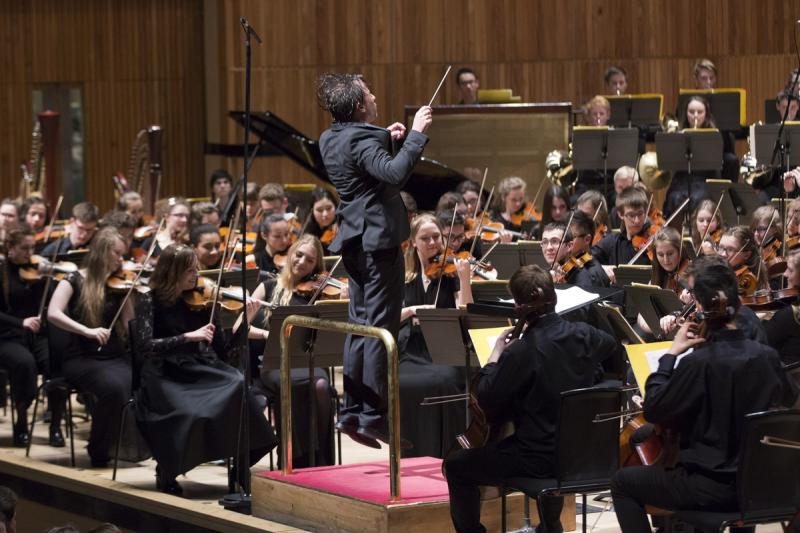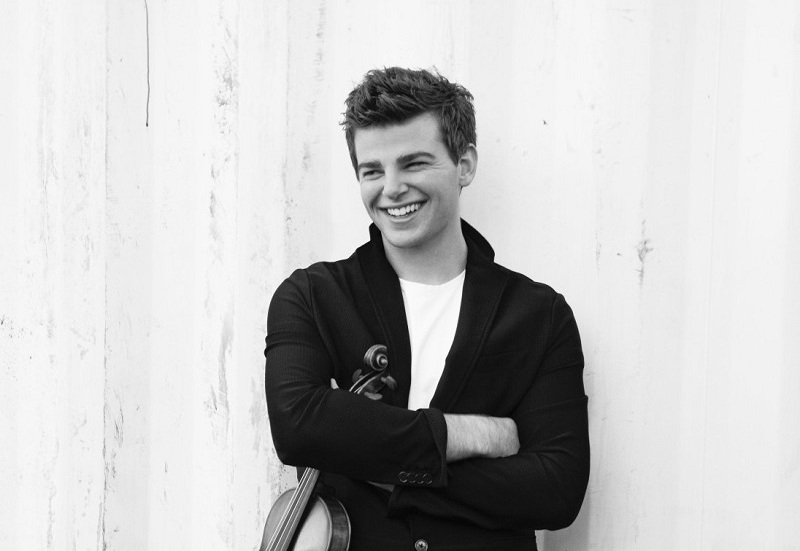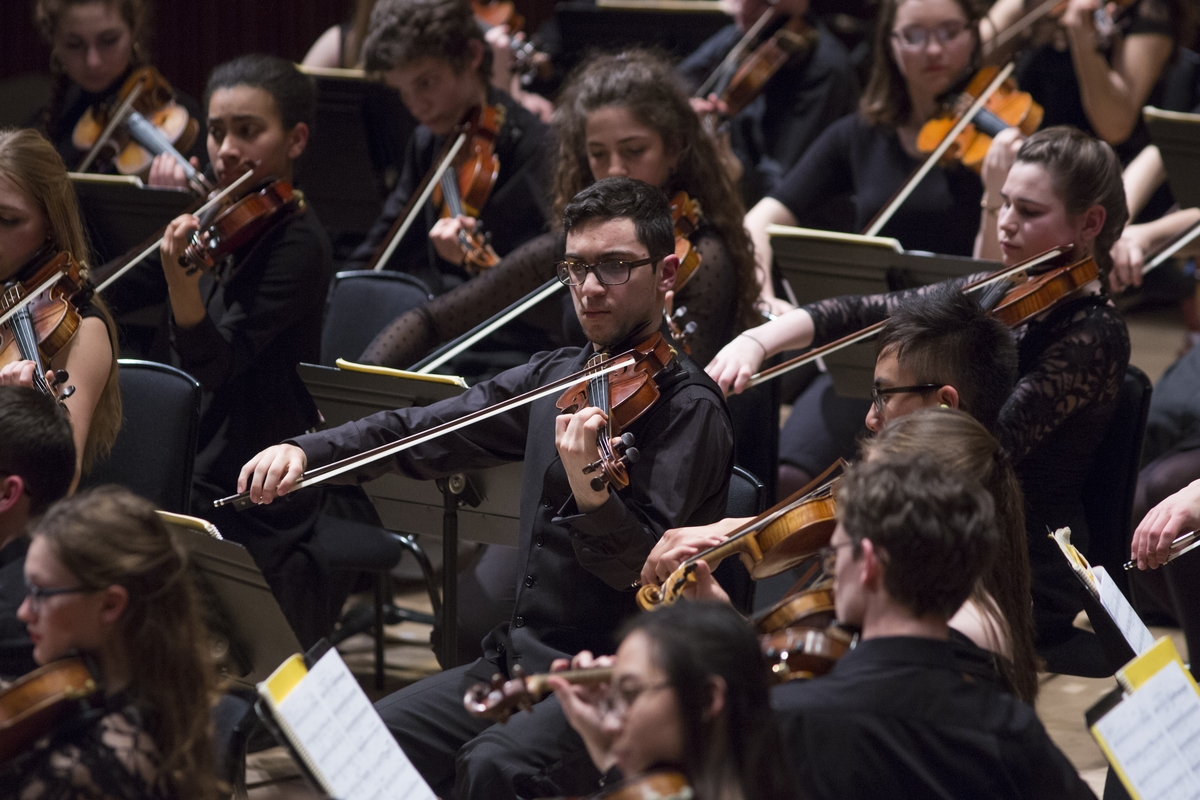Hoopes, National Youth Orchestra, Järvi, RFH | reviews, news & interviews
Hoopes, National Youth Orchestra, Järvi, RFH
Hoopes, National Youth Orchestra, Järvi, RFH
Adrenalin rushes plus sophistication in fire music by Stravinsky and Daugherty

On the panel to judge a competition between 14 Dutch school orchestras in Amsterdam's Concertgebouw last month, I couldn't resist using my speech to compare their state-school provenance with our own divisive musical education. I was thinking of two figures I'd been given – that when the National Youth Orchestra of Great Britain started, only five per cent of its young musicians were from private and public schools, whereas now it was 85 per cent.
Last week I learned the latter figure was wrong: current CEO and Artistic Director Sarah Alexander has got it down to 50/50, working on the notion that if a state school musician is less polished at auditions, he or she may stand to gain more from the experience. Standards have not been compromised; last night's was as stunning a concert as any from the NYO, with an extra adrenalin rush from the youngest of the Järvi conducting dynasty, Kristjan, no less individual than his brother or father. Without a doubt the culminating performance of Stravinsky's complete Firebird ballet was the most physically exciting I've ever heard. That its livestream, available for a limited time, wasn't taken up by BBC Four is a great pity – it would have won orchestral music new admirers – but at least the Southbank is reaching out to showcase this extraordinary institution in a way that the Barbican did not. Watch this space for further developments with its new associate orchestra.
 “As each of the works on the programme begins with ‘fire’,” writes leader Millie Ashton in the programme, “there’s no way NYO’s energy and totally teenage passion won’t do so.” The least familiar flames came from American composer Michael Daugherty’s Fire and Blood, a showcase for the orchestra and the soloist, Chad Hoopes (pictured above), who won first prize in the Young Artists Division of the Menuhin Competition 10 years ago (the current London competition is running this week).
“As each of the works on the programme begins with ‘fire’,” writes leader Millie Ashton in the programme, “there’s no way NYO’s energy and totally teenage passion won’t do so.” The least familiar flames came from American composer Michael Daugherty’s Fire and Blood, a showcase for the orchestra and the soloist, Chad Hoopes (pictured above), who won first prize in the Young Artists Division of the Menuhin Competition 10 years ago (the current London competition is running this week).
He’s the real thing: full, passionate tone, great intensity and musical intelligence. Daugherty’s concerto, though entertaining and tuneful, isn’t. Sounding like Khachaturian on a good day (which that composer’s Violin Concerto isn’t), its outer movements homaging the American motor industry are full of lively syncopations and opportunities for the large percussion section to switch instruments, as well as a good mix of double and treble stopping runs and singing lines for the soloist. The slow movement, “River Rouge”, runs on too long, and the mountain eventually gives birth to a molehill in the mariachi tune led by two trumpets (superb Tijuana touches here from Aaron Akugbo and Adam Meyer). Still, it was wonderful to see the rapport between Hoopes and Järvi, and the encore – a movement from Telemann’s Ninth Suite which Hoopes had played in the first round of the competition – provided a needful drop in temperature.
There was nowhere in the two Stravinsky works to relax; Järvi is a coiled spring bringing feverishness even to the more feminine dances of The Firebird. His full-body expressionism wasn’t to all tastes, but as another musician put it, he gives energy to the young players rather than leaching it from them. You could hear what you saw as Fireworks exploded towards its final display; you could gauge the results from the huge string section – 20 each of violin sections, 12 double basses bringing revelations to The Firebird’s “Infernal Dance” – on which he lavished the most love, with Los Angeles/Hollywood Bowl voluptuousness at times. Neither woodwind or brass seemed to suffer from the relative lack of attention.
 It’s also worth remembering that Stravinsky was only 25 when Diaghilev found himself captivated by Fireworks and (eventually) gave him the job of a long first original score for the Ballets Russes. The Firebird’s first half can feel over mimetic, over languorous, but not in the hands of players who are young enough to treasure its naïve storytelling. Surtitles with the action, Philharmonia-style, would have helped, but all eyes were still on Järvi and his players. Winsome woodwind solos, outstanding especially from oboist Eleanor Sullivan, carried the narrative; after the devastating climactic dance, faster than I’ve ever heard it but also exemplary in its clarity, and an unusually slow Berceuse led by bassoonist Lucy Dundas, the soul of ogre Kashchey inside an egg was smashed to brilliant smithereens and out of the magical string tremolos – these players can do the most sophisticated pianissimos – came an absolutely perfect horn solo from Livi Gandee.
It’s also worth remembering that Stravinsky was only 25 when Diaghilev found himself captivated by Fireworks and (eventually) gave him the job of a long first original score for the Ballets Russes. The Firebird’s first half can feel over mimetic, over languorous, but not in the hands of players who are young enough to treasure its naïve storytelling. Surtitles with the action, Philharmonia-style, would have helped, but all eyes were still on Järvi and his players. Winsome woodwind solos, outstanding especially from oboist Eleanor Sullivan, carried the narrative; after the devastating climactic dance, faster than I’ve ever heard it but also exemplary in its clarity, and an unusually slow Berceuse led by bassoonist Lucy Dundas, the soul of ogre Kashchey inside an egg was smashed to brilliant smithereens and out of the magical string tremolos – these players can do the most sophisticated pianissimos – came an absolutely perfect horn solo from Livi Gandee.
The riotous happy ending was even capped by the encore, Tchaikovsky’s "Dance of the Tumblers" from his Snow Maiden music – usually overshadowed by Rimsky-Korsakov’s version, but the Järvi family always find unusual encores. With standing trumpets and audience participation, it had a touch of the Simón Bolívar Orchestra’s showbiz about it, and that’s something we could all do with to add to the sheer joy of youthful music-making.
- Programme repeated in Liverpool tonight (9 April) and Manchester (10 April)
- Livestream of the concert available for a limited time on the Southbank's YouTube channel
- David Nice's blog on Orkestival 2016, the Dutch festival of school orchestras
rating
Explore topics
Share this article
The future of Arts Journalism
You can stop theartsdesk.com closing!
We urgently need financing to survive. Our fundraising drive has thus far raised £49,000 but we need to reach £100,000 or we will be forced to close. Please contribute here: https://gofund.me/c3f6033d
And if you can forward this information to anyone who might assist, we’d be grateful.

Subscribe to theartsdesk.com
Thank you for continuing to read our work on theartsdesk.com. For unlimited access to every article in its entirety, including our archive of more than 15,000 pieces, we're asking for £5 per month or £40 per year. We feel it's a very good deal, and hope you do too.
To take a subscription now simply click here.
And if you're looking for that extra gift for a friend or family member, why not treat them to a theartsdesk.com gift subscription?
more Classical music
 Helleur-Simcock, Hallé, Wong, Bridgewater Hall, Manchester review - moving lyricism in Elgar’s concerto
Season opener brings lyrical beauty, crisp confidence and a proper Romantic wallow
Helleur-Simcock, Hallé, Wong, Bridgewater Hall, Manchester review - moving lyricism in Elgar’s concerto
Season opener brings lyrical beauty, crisp confidence and a proper Romantic wallow
 Kohout, Spence, Braun, Manchester Camerata, Huth, RNCM, Manchester review - joy, insight, imagination and unanimity
Celebration of the past with stars of the future at the Royal Northern College
Kohout, Spence, Braun, Manchester Camerata, Huth, RNCM, Manchester review - joy, insight, imagination and unanimity
Celebration of the past with stars of the future at the Royal Northern College
 Jansen, LSO, Pappano, Barbican review - profound and bracing emotional workouts
Great soloist, conductor and orchestra take Britten and Shostakovich to the edge
Jansen, LSO, Pappano, Barbican review - profound and bracing emotional workouts
Great soloist, conductor and orchestra take Britten and Shostakovich to the edge
 Jakub Hrůša and Friends in Concert, Royal Opera review - fleshcreep in two uneven halves
Bartók kept short, and a sprawling Dvořák choral ballad done as well as it could be
Jakub Hrůša and Friends in Concert, Royal Opera review - fleshcreep in two uneven halves
Bartók kept short, and a sprawling Dvořák choral ballad done as well as it could be
 Hadelich, BBC Philharmonic, Storgårds, Bridgewater Hall, Manchester review - youth, fate and pain
Prokofiev in the hands of a fine violinist has surely never sounded better
Hadelich, BBC Philharmonic, Storgårds, Bridgewater Hall, Manchester review - youth, fate and pain
Prokofiev in the hands of a fine violinist has surely never sounded better
 Monteverdi Choir, ORR, Heras-Casado, St Martin-in-the-Fields review - flames of joy and sorrow
First-rate soloists, choir and orchestra unite in a blazing Mozart Requiem
Monteverdi Choir, ORR, Heras-Casado, St Martin-in-the-Fields review - flames of joy and sorrow
First-rate soloists, choir and orchestra unite in a blazing Mozart Requiem
 Cho, LSO, Pappano, Barbican review - finely-focused stormy weather
Chameleonic Seong-Jin Cho is a match for the fine-tuning of the LSO’s Chief Conductor
Cho, LSO, Pappano, Barbican review - finely-focused stormy weather
Chameleonic Seong-Jin Cho is a match for the fine-tuning of the LSO’s Chief Conductor
 Classical CDs: Shrouds, silhouettes and superstition
Cello concertos, choral collections and a stunning tribute to a contemporary giant
Classical CDs: Shrouds, silhouettes and superstition
Cello concertos, choral collections and a stunning tribute to a contemporary giant
 Appl, Levickis, Wigmore Hall review - fun to the fore in cabaret and show songs
A relaxed evening of light-hearted fare, with the accordion offering unusual colours
Appl, Levickis, Wigmore Hall review - fun to the fore in cabaret and show songs
A relaxed evening of light-hearted fare, with the accordion offering unusual colours
 Lammermuir Festival 2025, Part 2 review - from the soaringly sublime to the zoologically ridiculous
Bigger than ever, and the quality remains astonishingly high
Lammermuir Festival 2025, Part 2 review - from the soaringly sublime to the zoologically ridiculous
Bigger than ever, and the quality remains astonishingly high
 BBC Proms: Ehnes, Sinfonia of London, Wilson review - aspects of love
Sensuous Ravel, and bittersweet Bernstein, on an amorous evening
BBC Proms: Ehnes, Sinfonia of London, Wilson review - aspects of love
Sensuous Ravel, and bittersweet Bernstein, on an amorous evening
 Presteigne Festival 2025 review - new music is centre stage in the Welsh Marches
Music by 30 living composers, with Eleanor Alberga topping the bill
Presteigne Festival 2025 review - new music is centre stage in the Welsh Marches
Music by 30 living composers, with Eleanor Alberga topping the bill

Add comment